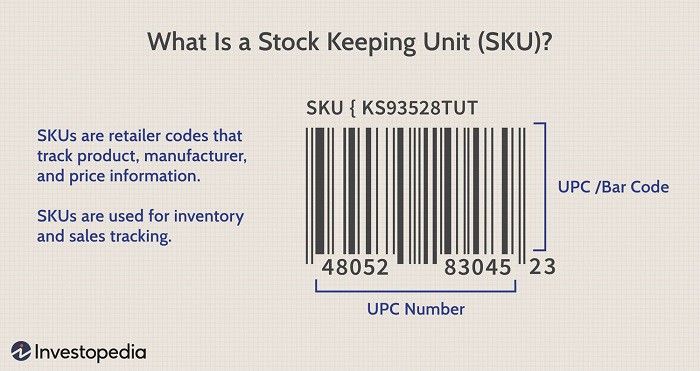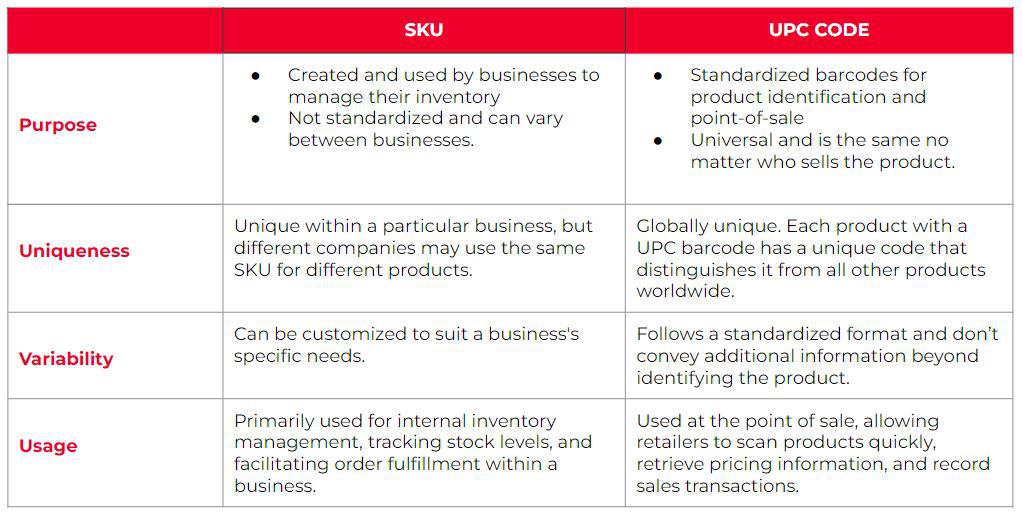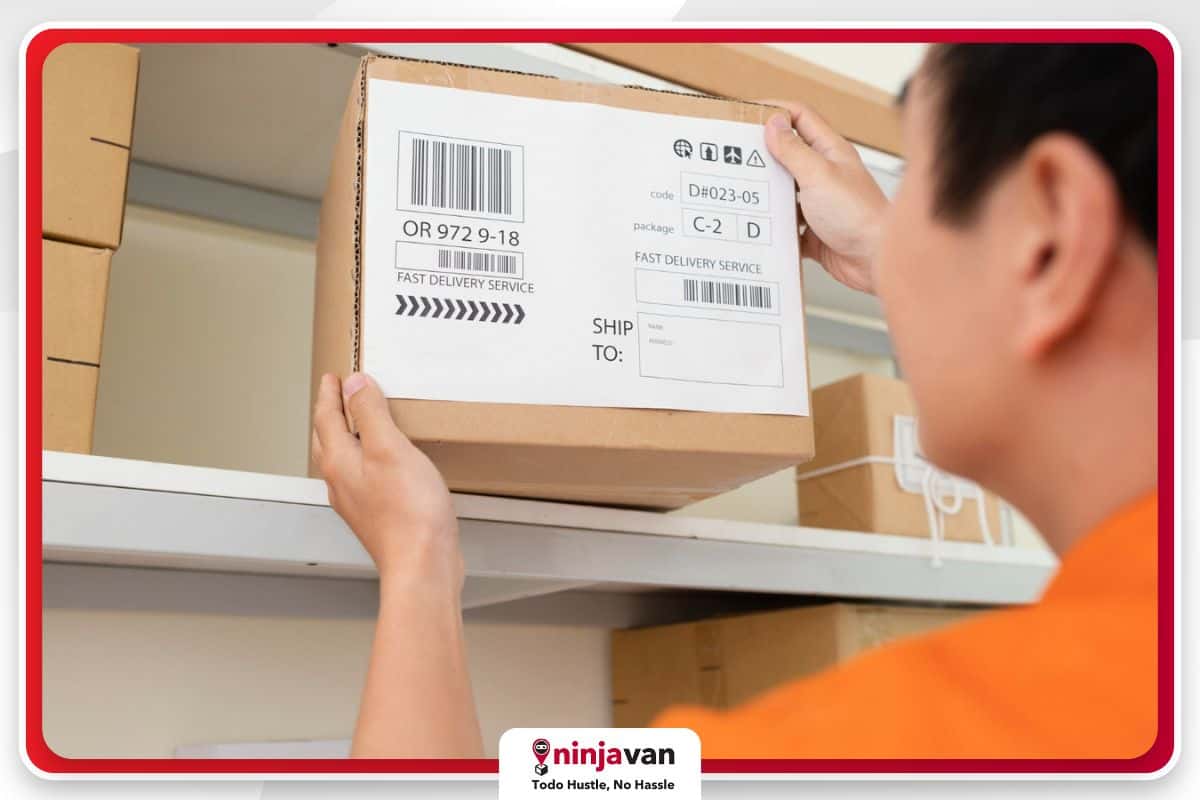SKU stands for Stock Keeping Unit. It’s a unique code or identifier used by businesses and retailers to track and manage their inventory.
Each SKU corresponds to a specific product or item and helps businesses differentiate between various products they have in stock. They’re also unique to the business, meaning two companies selling the same product (for example a white T-shirt) would issue two different internal SKUS.
Also read: Inventory Management Techniques for Online Sellers
What is an SKU number?
SKU numbers are typically alphanumeric codes (numbers and letters), and they include product information and relevant attributes including:
- Product type or category
- Size
- Color
- Style or variant
- Manufacturer or supplier information
- Pricing information
- Location within the store or warehouse

The exact format and structure of SKU numbers can vary from one business to another. Businesses often create SKU numbering systems that are tailored to their specific needs and the complexity of their inventory.
SKU vs UPC
People sometimes mistake SKU as similar to and UPC (Universal Product Code). While they’re both used in retail and inventory management, they serve different purposes and have distinct characteristics.

Why ecommerce businesses need SKU
Creating SKU numbers are crucial for ecommerce businesses, especially with growing demand and competition around the world. While building a robust inventory management system, SKU numbers are a critical component of that system
Here are several important reasons for having SKUs.
1. Accurate inventory and supplier management
Your SKUs enable you to keep track of your product inventory accurately. Each SKU corresponds to a specific product variant, making it easier to monitor stock levels and avoid overstocking or running out of popular items.
Your SKU numbers can also include supplier or manufacturer information, which helps in managing relationships with your suppliers, tracking your product sources and ensuring consistent quality.
2. Streamline your order fulfillment
When an order comes in, having SKUs allows you to quickly identify and pick the correct products from their warehouse, reducing the chances of shipping errors and facilitating efficient order processing.
Each SKU corresponds to a specific product variant, making it easier to monitor stock levels and avoid overstocking or running out of popular items.
3. Organized records of product variants
Ecommerce businesses often offer products with various options like size, color and style.
With SKUs, you can maintain organized and accurate records of products in your inventory management system, which is crucial for overall business efficiency.
This will also ensure customers will receive the exact product they ordered and you can even make customized recommendations to your customers.
4. Analyze sales data
SKUs are valuable for analyzing product sales data. You can use SKU-level data to identify your top-selling products, track the performance of different variants, and make informed decisions about inventory and marketing strategies.
5. Manage pricing and promotions
You can link your SKUs to the pricing information of your products. This will allow you to fine-tune your pricing strategies at a granular level. You can make precise pricing adjustments for specific product variants when implementing targeted promotions, dynamic pricing and bundle/package pricing.
How to create SKU numbers: 10 tips for you
Creating your SKU numbers involves developing a systematic and unique identification system for your products or inventory items. Here’s a step-by-step guide on how to create SKU numbers:

Understand your products. Begin by understanding the products you sell and the attributes that distinguish them. Consider factors like size, color, style, manufacturer, and any other relevant characteristics.
Establish a format. Decide on a consistent format for your SKU numbers. This format should be meaningful and reflect the attributes of your products. Common formats include a combination of letters, numbers, and symbols.
Assign codes for each product. Assign codes or abbreviations to represent each attribute of your products within the SKU. For example, ABC12345: ABC could represent the product category, and 12345 could represent the size and color.
Here’s another example: You’re selling a rain jacket in 2023, medium size, color red, and you have 10 of this variant in stock. Your SKU can look like this: RN23-JK-RD-M-010 (the last number series citing this is the 10th item of this variant in your stock)
Ensure uniqueness. It’s crucial to ensure that each SKU is unique within your inventory. Avoid duplicate SKUs to prevent confusion and errors.
Use descriptive labels. Make sure the SKU provides enough information for easy identification. This can help employees quickly locate products and assist with inventory management.
Avoid special characters. While some special characters may be used in SKUs, it’s generally a good practice to keep them to a minimum to avoid potential issues with software systems or barcode readers.
Test and validate. Test your SKU system to ensure it works effectively. Verify that SKUs are unique, easy to understand, and can be easily associated with specific products.
Document the system. Document the SKU system, including the format, codes, and any rules or guidelines, so that employees can follow it consistently.
Implement and train. Implement the SKU system in your inventory management software or system. Train your team members or your fulfillment partner on how to create and use SKUs correctly.
Review and update. Periodically review your SKU system to ensure it remains effective as your product catalog evolves. Update SKUs as needed to accommodate new products or changes in your business.
Creating effective SKU numbers can significantly improve your inventory management, order processing, and overall organization, leading to more efficient operations in your business.
Outsource your inventory management and fulfillment
SKU numbers are crucial for maintaining accurate and organized inventory records for your products. They reduce errors and improve overall operational efficiency of your inventory management.

so you can focus on growing your business!
But as your business grows, managing your inventory and doing your order fulfillment may not be the efficient way to do things. Your time is better maximized for other things like building your brand and creating your marketing strategy.
Ninja Van’s Fulfillment and Warehousing provides cost-effective logistics solutions for your ecommerce business. While streamlining your order fulfillment, you also save on manpower, warehouse storage rental, and other costs.
Here’s what Ninja Fulfillment can do for you:
- Inventorizing and storing your products
- Pickup and packing your orders
- Delivering your orders to the end customers
- Live view of your inventory
- Live update of your order’s status
- Free pickup within Metro Manila and Laguna
- Same-day handover to the courier
- Free returns to fulfillment warehouse
- Importation and sourcing assistance
Ninja Fulfillment also offers customized warehouse management solutions to meet your ecommerce business needs.
For inquiries about Ninja Fulfillment:
- Reach out to Erick Paul Ramos at 0917-7161495
- Send an email to ph-niu-fulfillment@ninjavan.co
More tips for your growing ecommerce business:
How Ninja Van Can Boost Your ECommerce Fulfillment
How Does 3PL Work?
Choosing A Warehouse Logistics Partner 101






